
Product test
Alienware AW3225QF review: dawn of a new era
by Samuel Buchmann

The new 4K OLED from Asus is one of the most popular monitors on the market right now. It met my high expectations when I tested it. The only thing that was hard to swallow was the price.
A month ago, I described 32-inch 4K OLEDs as the new era of monitors. The Asus ROG Swift PG32UCDM is the second example I’ve seen with my own eyes. It uses the same QD-OLED panel as the Alienware model that impressed me in my review.
However, Asus does a few things differently. Firstly, the PG32UCDM is flat. Secondly, it offers additional functions and more ports than the Alienware AW3225QF. The Taiwanese manufacturer also charges 50 per cent more for this. Here are the key stats at a glance:
Asus says the PG32UCM has a «futuristic, cyberpunk-inspired aesthetic.» I’m not convinced. To me, it looks like any other monitor in the ROG series: sci-fi design with a three-legged stand and a few RGB gimmicks. For example, the brand logo projected onto the tabletop.
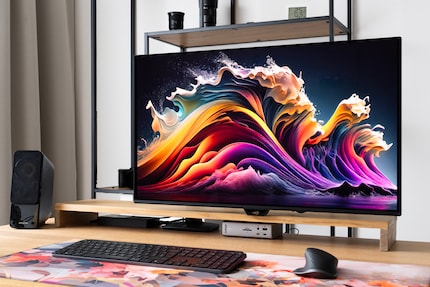
Being anti-RGB, the first thing I do is turn off everything that lights up. Once that’s done, the design’s fine for me. The metal base ensures good stability. And if I screw the screen onto a monitor arm instead, it looks nice and simple. The display edges are thin, the back is inconspicuously black.
Asus cools the monitor passively. There’s a graphene film behind the OLED panel, which is intended to optimally dissipate the heat and transfer it to the heatsink. According to the manufacturer, this keeps the panel cool and reduces the risk of burn-in. As always, it’s impossible to say how well it works without long-term testing.
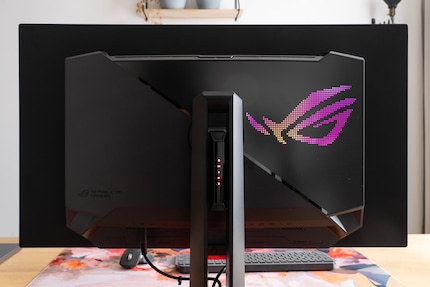
There’s a good port selection: two HDMI 2.1, one DisplayPort 1.4 and USB-C with 90-watt power delivery. I’m particularly pleased with the latter. In addition to my Windows PC, I can also plug in my MacBook without an adapter. Like most manufacturers, Asus still doesn’t use DisplayPort 2.1.
Unlike the competition from Alienware, the PG32UCM is flat rather than curved. Personally, I like this better for a single-screen setup. The OLED panel has such a stable viewing angle that there are still no colour shifts towards the edges. For a multi-screen setup, I’d prefer the curved Alienware AW3225QF.
The following is a deep dive. Measurements carried out with professional tools from Portrait Display allow an objective classification of image quality. If you’re not interested in details and diagrams, you can read the short version and then scroll to the «Gaming» section.
Here’s a summary of the key stats:
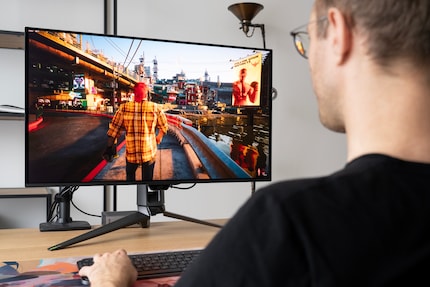
Samsung’s third-generation QD-OLED panel in the Asus PG32UCDM has a maximum full-screen brightness of almost 246 nits. Although monitors with LCD panels can reach higher brightness levels, this should still be enough for most situations It only gets a bit close to its limit when the sun shines directly into your room, depending on the image content.
What Asus does better than Alienware with the AW3225QF is that you can select dynamic brightness in both HDR and SDR mode. To do this, you deactivate the «Uniform Brightness» option in the menu. Then the brightness of the white increases as soon as it no longer fills the entire screen. With a white content (more precisely, an average picture level or APL) of up to 10 per cent, the panel achieves 426 nits in SDR mode.
This option – which the competition doesn’t have – makes it more pleasant to game in bright rooms. Especially in games, the APL is almost always below 100 per cent – and it isn’t even disruptive if the brightness of the white constantly changes a little. For office work, however, the mechanism annoys me and I switch it off. I think it’s exemplary that Asus gives me free choice as a user.
The panel of my test sample is extremely evenly illuminated. I measure a maximum DeltaE of 1.1 between the centre and edges of the image.
The HDR brightness is also good at low APL, with the PG32UCDM achieving the promised 1,000 nits in a 2 per cent window. However, with larger test windows, the brightness drops just as quickly as with the Alienware AW3225QF. In the 10 per cent window, there are only 480 nits. The QD-OLED panel has a more aggressive Auto Brightness Limiter (ABL) than, for example, the WOLED panel of the Asus PG34WCDM. That’s why the experience seems a little less impressive in brightly lit scenes.
As with all OELD monitors, the contrast tends towards infinity – black is black. However, there’s a small limitation: QD-OLED panels, like on the Asus PG32UCDM, don’t have a polarization filter. The black therefore appears a bit washed out and purple in bright surroundings. WOLED panels are better at this. But I only notice the difference in direct comparison.
The gloss coating of the PG32UCDM is also a slight disadvantage in bright rooms – although it reflects surprisingly little. It also performs well in dark environments, with the image appearing crisper and richer than on matte screens.
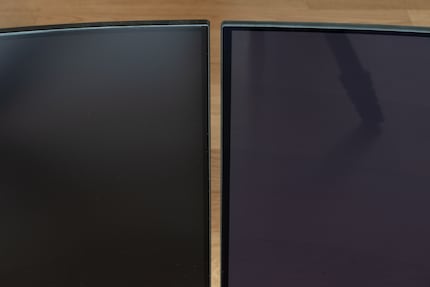
Measuring colours and grey tones is intended to answer three questions:
The PG32UCDM’s gamma curve is close to its target value. Grey tones tend to be a bit too light, but at least this prevents black crush. The monitor is slightly weak when it comes to white balance. On the one hand, it’s too cool, but on the other, grey tones have a magenta tint – the lighter the tones, the stronger the tint.
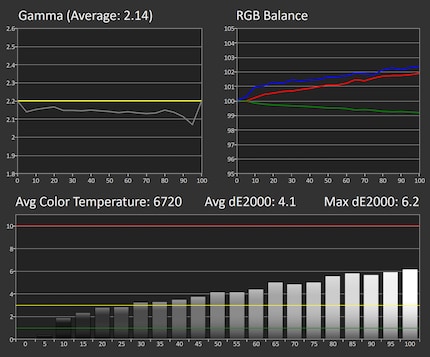
Fortunately, there’s only very moderate deviation and I can correct it at the hardware level using a manual RGB white balance. The maximum DeltaE then drops to an invisible 1.4.
The PG32UCDM covers the common SDR colour spaces very well:
As with the Alienware AW3225QF, the almost complete coverage of AdobeRGB is impressive. The factory calibration of the Asus PG32UCDM is fine for a gaming monitor. In default settings, the average sRGB DeltaE is 4.7. As with many wide-gamut monitors, content is displayed a little too richly.
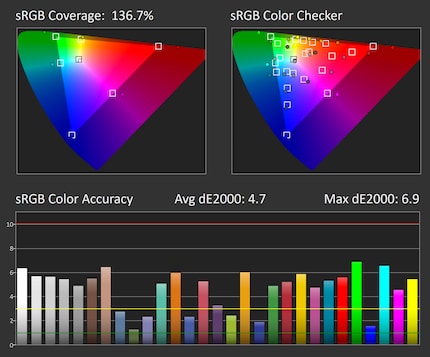
Changing the monitor’s colour space to sRGB in the settings improves the accuracy. Only the grey tones aren’t neutral – a consequence of the aforementioned white balance weakness. However, these colour deviations can all be minimised with calibration. Once that’s done, the PG32UCDM is also very suitable for image editing or video editing.
OLED monitors like the PG32UCDM are naturally well-suited to HDR content. By switching off individual pixels, they can achieve precise demarcations between very bright and very dark content, such as explosions in a night scene. Even dark grey tones are usually cleanly differentiated so that details can still be seen in shadows.
Asus has tuned its monitor really well. EOTF and luminance curves barely deviate from the target values. And the white balance is even better calibrated than in SDR mode. As described in the section on brightness, the luminosity drops relatively quickly as the white content increases. The monitor only manages the promised 1,000 nits in the 2 per cent window. In reality, the APL is often 10 per cent, even in dark scenes. This is where the latest WOLED panels are over half brighter than the QD-OLED panel in the PG32UCDM.
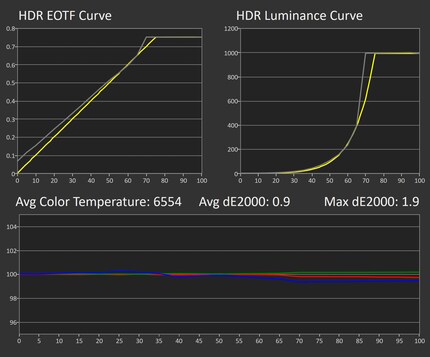
In terms of covering the HDR colour spaces, I measure:
Coverage of the very large BT.2020 colour space is almost 80 per cent. That’s good, but not outstanding for QD-OLED. My colleague Luca Fontana regularly measures coverage of over 90 per cent for TVs with this panel technology.
In practice, this is barely relevant. Most content today is aligned with DCI-P3. This colour space is covered excellently by the PG32UCDM at 99 per cent. The monitor displays colours very accurately, even in HDR. The average DeltaE of 2 is very low.
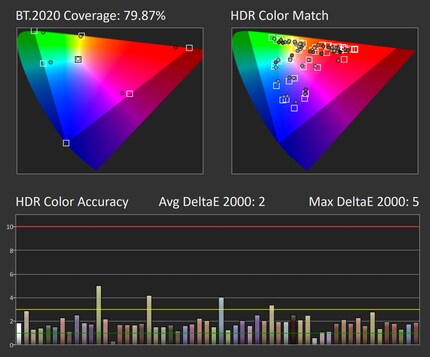
At the time of testing, the Asus PG32UCDM supported the HDR10 standard, but not yet DolbyVision or HDR10+. According to the manufacturer, the former will follow by mid-2024. That’s not a big deal, as there are only a few games in Dolby Vision anyway.
The PG32UCDM is a fantastic gaming monitor: high pixel density, deep blacks, crisp contrasts and rich colours that still look natural. The image stays sharp, even during fast movements, thanks to the frame rate of 240 hertz and the low response time of the OLED panel. Overall, the image quality is one of the best that current technology can offer.
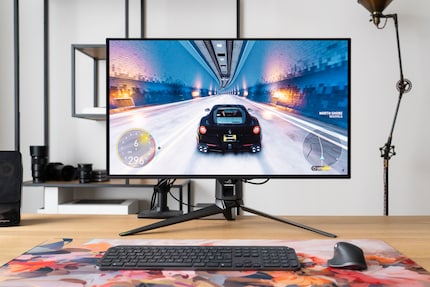
So far, so predictable. After all, I wrote similar things when I tested the Alienware AW3225QF with the same panel. But is a 4K OLED actually the best choice, or should you spend your money on another type of monitor?
As is often the case, there’s no catch-all answer to this. One thing’s clear: the Asus PG32UCDM is an excellent all-rounder. Depending on your preferences, a different type of monitor may still suit you better. These are the current high-end alternatives:
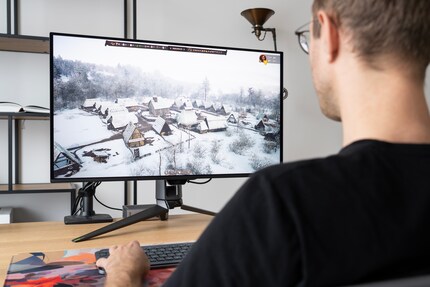
I’ve already tested all the models myself. My personal conclusion: the new 32-inch OLEDs are the best of both worlds. In strategy games like Manor Lords, I appreciate the height of the screen. What strikes me in role-playing games is the sheer depth of detail of the high pixel density. As an amateur, I’m overjoyed with a frame rate of 240 hertz in shooters.
Are there times when I wish I had the immersion of a larger monitor? Of course. But they all have poorer image quality and I find monster displays a bit overwhelming when I’m working. There’s space for an opened MacBook next to the 32-inch model. I prefer this small dual-screen setup.
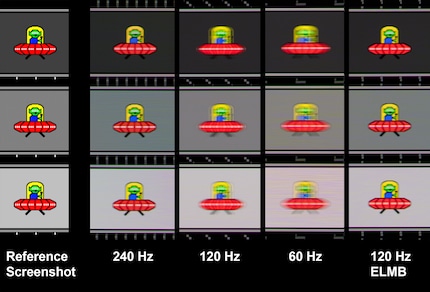
By the way, Asus has a trick up its sleeve if your PC can’t achieve 240 fps in a game. If you set the frame rate to 120 hertz, there’s the Extreme Low Motion Blur (ELMB) option. This causes the monitor to insert a black image between each frame, meaning that the motion blur remains as low as at 240 hertz. However, this only works in SDR, there’s no variable refresh rate (VRR) and the maximum brightness is halved.
The Asus PG32UCDM is also suitable for work. Thanks to a better subpixel pattern than previous OLED generations and the high pixel density, text looks really sharp. Colour fringes on edges with high contrast are no longer visible to the eye. The colour accuracy and good colour space coverage do the rest.

The PG32UCDM looks great whether I’m writing or editing images. It also doesn’t have an Auto Static Brightness Limiter (ASBL), which would annoy me. The screen saver also dims the image after a while – but all it takes is one mouse movement to deactivate it. The option can also be switched off completely in the menu.
The only disadvantage for office use is the risk of burn-in. I still can’t see any signs of ghosting after a month. But this isn’t a meaningful long-term test. As with all OLED monitors, displaying static image elements for hours on end probably isn’t a good idea, especially if you set the screen bright. Dark mode and lower brightness can reduce the risk. Personally, I don’t feel like doing either during the day.
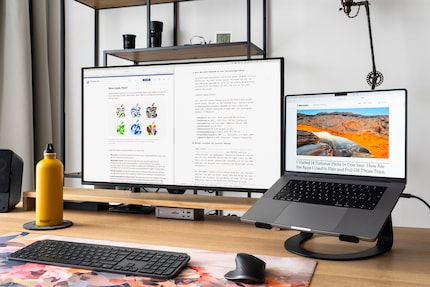
Asus offers a three-year guarantee on burn-in and uses the usual protective measures. Static logos are automatically recognised and dimmed, and the entire image is regularly shifted by a few pixels. A Pixel Cleaner frees the panel from temporary ghost images.
The integration of the Pixel Cleaner initially confused me: after eight hours, the monitor reminds me that I should start a cleaning process. But the message pops up in the middle of using it, so I usually don’t want to interrupt my work or play – and then I forget about it.
As you can see on the support page, there’s also an automatic process. I only noticed this when a user pointed it out. Unlike the Alienware AW3225QF, the Pixel Cleaner only starts after five minutes of me putting the monitor into standby mode rather than immediately. This is indicated by five light pulses from the ROG logo on the front – but only if you haven’t deactivated the lights like I did.
The unclear automatic pixel cleaner remains the only small weak point in terms of usage. I haven’t noticed any bugs. Asus has also made the menu navigation logical and clear – and still offers me a lot of settings options. SDR and HDR options are saved separately, so you don’t have to fumble around every time you switch from one mode to the other.
You operate the menu using a joystick and two buttons on the lower centre of the back. All have clear pressure points. After a while, I’ve remembered the shortcuts to the most important functions:
I think it’s great that Asus lets you set almost everything independently. Other manufacturers tie the colour space or gamma value to specific image modes. You can also determine a manual white balance in the sRGB colour space and set the gamma to 2.4. Generally speaking, there are a lot of options to manually calibrate the image at hardware level.
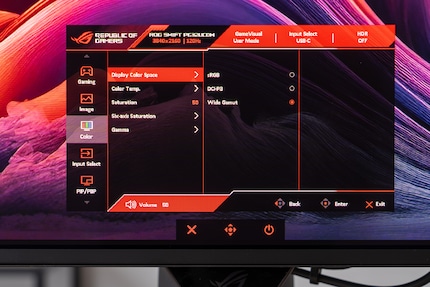
The power consumption is typical of OLED monitors. They draw more power than an LCD with LED lighting: the Asus PG32UCDM uses an average of around 50 watts at 75 per cent brightness. At maximum brightness, this can be as high as 105 watts with a completely white image.
«Has Asus just launched the perfect monitor?» I asked myself last year when the PG32UCDM came out. After the test, my answer is: pretty much. The third-generation QD-OLED panel lives up to the hype. Its high pixel density, perfect black levels and rich colour reproduction ensure bombastic image quality.
The size and image format are suitable for all types of games. With a frame rate of 240 hertz, even fast shooters look sharp. In 4K, you need a corresponding amount of graphics performance. The monitor also looks good in Office applications. However, as with any OLED, you should be aware of the risk of burn-in.
The question remains whether the Asus PG32UCDM is worth its premium compared to the Alienware AW3225QF – the price difference was a whopping 500 francs at the time of this test. In return, you get a USB-C port and more sophisticated firmware with more options. In games, the most important advantage is probably the dynamic SDR brightness, which the competition doesn’t have. Personally, I also prefer the flat design. Ultimately, the Asus PG32UCDM is my new king of gaming monitors, but the Alienware AW3225QF remains the winner in terms of value for money.
Pro
Contra
My fingerprint often changes so drastically that my MacBook doesn't recognise it anymore. The reason? If I'm not clinging to a monitor or camera, I'm probably clinging to a rockface by the tips of my fingers.